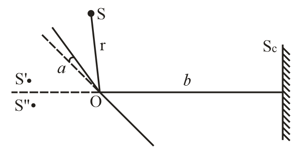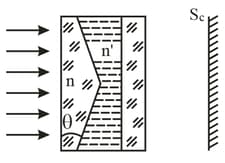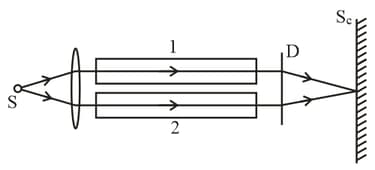Figure illustrates the interference experiment with Fresnel mirrors. The angle between the mirrors is the distances from the mirrors' intersection line to the narrow slit and the screen are equal to and , respectively. The wavelength of light is . Find:
(a) the width of a fringe on the screen and the number of possible maxima;
(b) the shift of the interference pattern on the screen, when the slit is displaced by along the arc of radius , with centre at the point ;
(c) at what maximum width of the slit, the interference fringes on the screen are still observed sufficiently sharp.

(a) the width of a fringe on the screen and the number of possible maxima;
(b) the shift of the interference pattern on the screen, when the slit is displaced by along the arc of radius , with centre at the point ;
(c) at what maximum width of the slit, the interference fringes on the screen are still observed sufficiently sharp.


Important Questions on OPTICS
(a) the width of a fringe on the screen and the number of possible maxima;
(b) the maximum width of the slit at which the fringes on the screen will be still observed sufficiently sharp.
A plane light wave with wavelength falls normally on the base of a biprism, made of glass with refracting angle . Behind the biprism there is a plane-parallel plate, with the space between them filled up with benzene . Find the width of a fringe on the screen placed behind this system.

Figure illustrates an interferometer used in measurement of refractive indices of transparent substances. Here is a narrow slit illuminated by a monochromatic light with wavelength , and are identical tubes with air of length each, is a diaphragm with two slits. After the air in tube was replaced with ammonia gas, the interference pattern on the screen was displaced upward by fringes. The refractive index of air is equal to . Determine the refractive index of ammonia gas.

